2022 TOYOTA SUPRA oil
[x] Cancel search: oilPage 217 of 498

215
3
3-1. CONTROLS
CONTROLS
The system reacts to pedestrians
and cyclists if your own speed is
below approx. 85 km/h, 53 mph.
The detection ability of the system
is limited.
As a result, the system may fail to
give warnings or may give warnings
late.
It is possible that the following are
not detected, for example:
Partially concealed pedestrians.
Pedestrians who are not
detected as such, because of the
viewing angle or outline.
Pedestrians outside the detec-
tion range.
Pedestrians less than approxi-
mately 80 cm, 32 in tall.
The system may have limited func-
tionality in some situations, for
example:
In thick fog, wet conditions or
snow.
On sharp bends.
If vehicle stability control sys-
tems are deactivated, for exam-
ple VSC OFF.
If the field of view of the camera
or the windscreen in front of the
rear-view mirror is soiled or cov-
ered.
If the camera has overheated
due to excessively high tempera-
tures and has been temporarily
deactivated.
Depending on the equipment
version: if the radar sensors are
soiled or covered.
Depending on the vehicle's
equipment: after work performed
incorrectly on the vehicle paint-
work.
Up to 10 seconds after starting
the engine using the start/stop
button.
During the camera calibration
process immediately after vehi-
cle delivery.
If there is sustained glare due to
oncoming light, for example if the
sun is low in the sky.
In the dark.
Attaching any objects – stickers or
System limits
Safety note
WA R N I N G
The system may not re spond at all, or may respond too late, incorrectly or
without justification due to limits of the
system. There is a danger of acci-
dents or damage to property.
Observe the information on the sys-
tem limits and intervene actively if
necessary.
Upper speed limit
Detection range
Functional limitations
Page 300 of 498
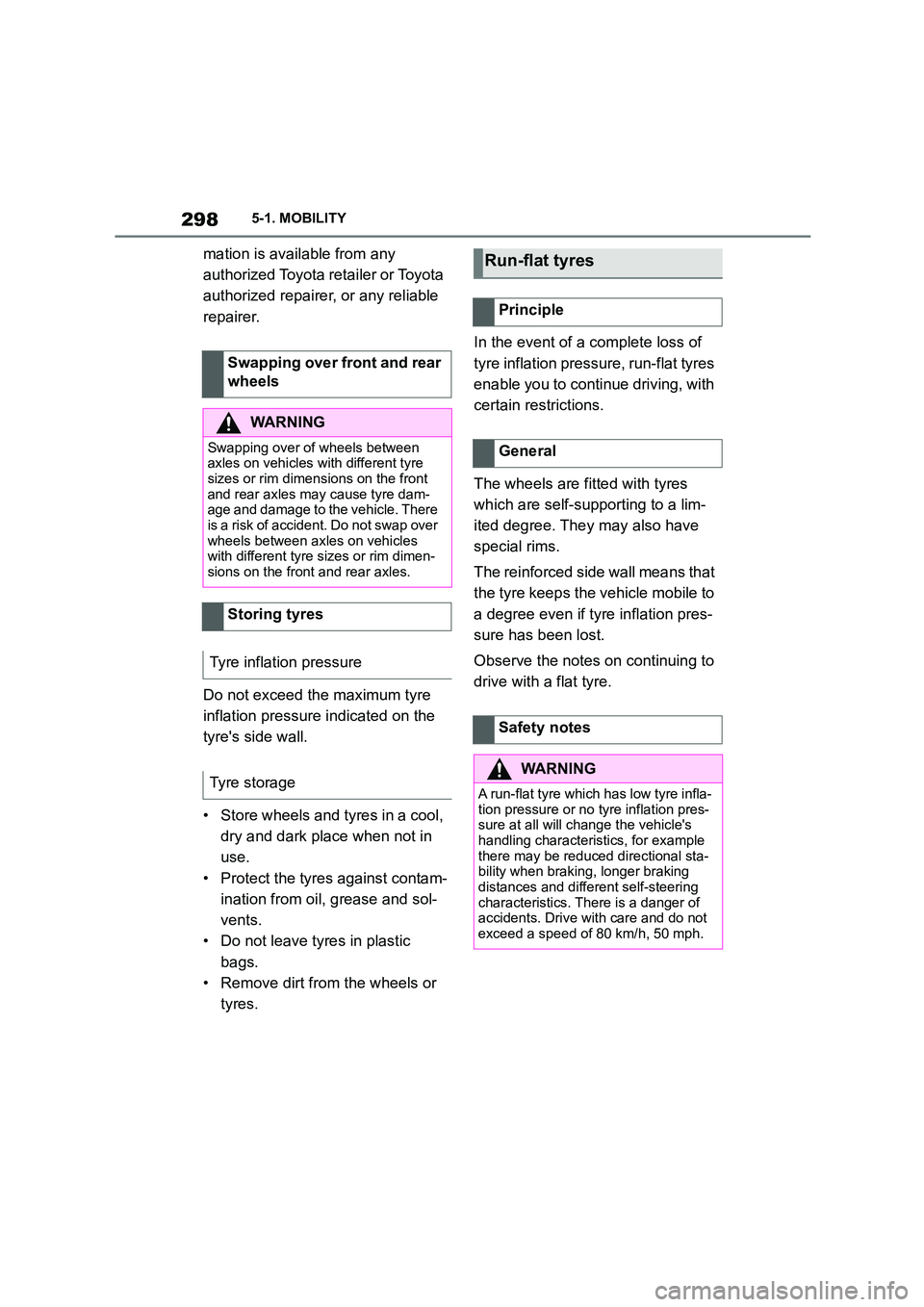
2985-1. MOBILITY
mation is available from any
authorized Toyota retailer or Toyota
authorized repairer, or any reliable
repairer.
Do not exceed the maximum tyre
inflation pressure indicated on the
tyre's side wall.
• Store wheels and tyres in a cool,
dry and dark place when not in
use.
• Protect the tyres against contam-
ination from oil, grease and sol-
vents.
• Do not leave tyres in plastic
bags.
• Remove dirt from the wheels or
tyres.
In the event of a complete loss of
tyre inflation pressure, run-flat tyres
enable you to continue driving, with
certain restrictions.
The wheels are fitted with tyres
which are self-supporting to a lim-
ited degree. They may also have
special rims.
The reinforced side wall means that
the tyre keeps the vehicle mobile to
a degree even if tyre inflation pres-
sure has been lost.
Observe the notes on continuing to
drive with a flat tyre.
Swapping over front and rear
wheels
WA R N I N G
Swapping over of wheels between
axles on vehicles with different tyre
sizes or rim dimensions on the front and rear axles may cause tyre dam-
age and damage to the vehicle. There
is a risk of accident. Do not swap over wheels between axles on vehicles
with different tyre sizes or rim dimen-
sions on the front and rear axles.
Storing tyres
Tyre inflation pressure
Tyre storage
Run-flat tyres
Principle
General
Safety notes
WA R N I N G
A run-flat tyre which has low tyre infla-
tion pressure or no tyre inflation pres- sure at all will change the vehicle's
handling characteristics, for example
there may be reduced directional sta- bility when braking, longer braking
distances and different self-steering
characteristics. There is a danger of accidents. Drive with care and do not
exceed a speed of 80 km/h, 50 mph.
Page 304 of 498
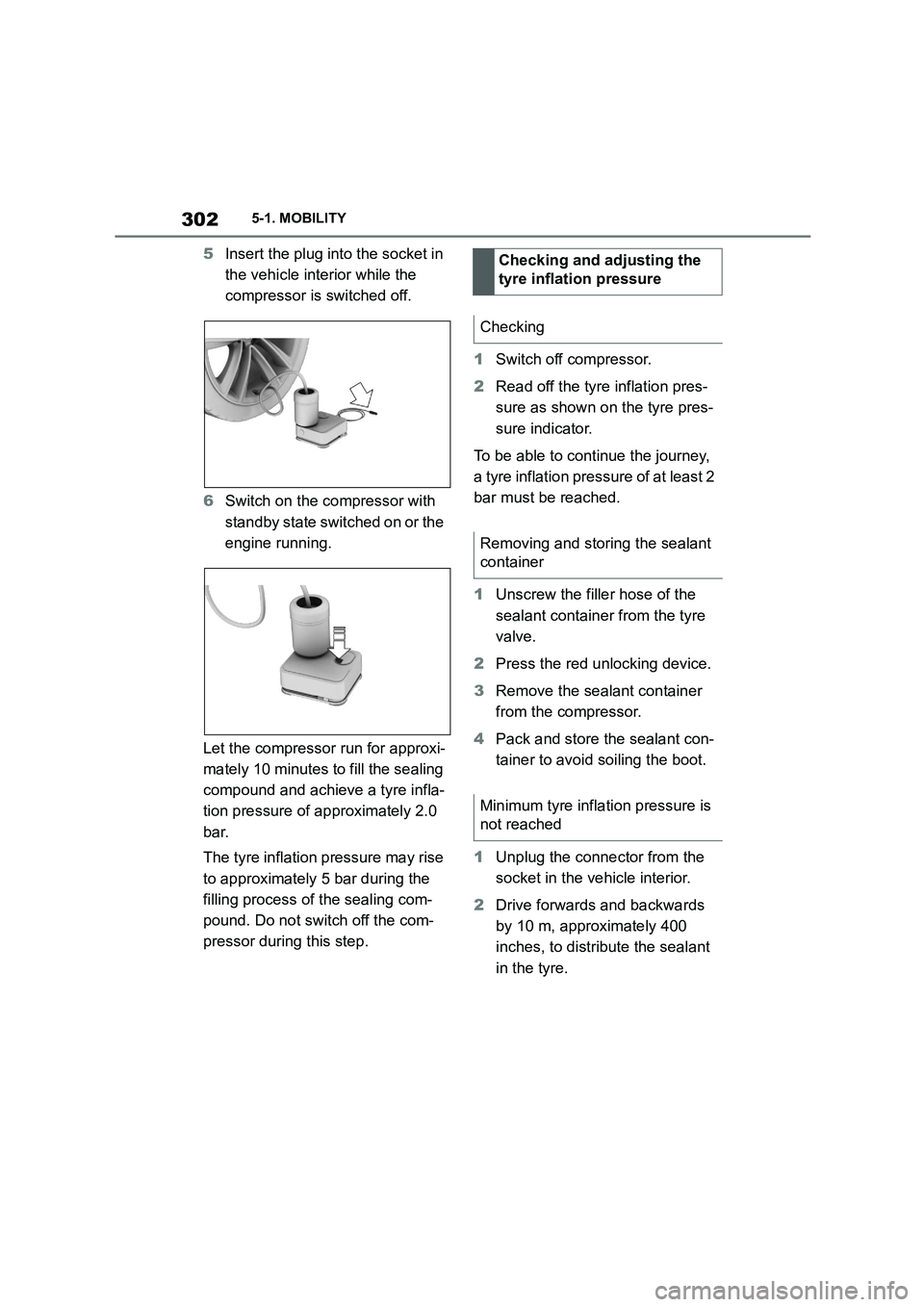
3025-1. MOBILITY
5Insert the plug into the socket in
the vehicle interior while the
compressor is switched off.
6 Switch on the compressor with
standby state switched on or the
engine running.
Let the compressor run for approxi-
mately 10 minutes to fill the sealing
compound and achieve a tyre infla-
tion pressure of approximately 2.0
bar.
The tyre inflation pressure may rise
to approximately 5 bar during the
filling process of the sealing com-
pound. Do not switch off the com-
pressor during this step.
1 Switch off compressor.
2 Read off the tyre inflation pres-
sure as shown on the tyre pres-
sure indicator.
To be able to continue the journey,
a tyre inflation pressure of at least 2
bar must be reached.
1 Unscrew the filler hose of the
sealant container from the tyre
valve.
2 Press the red unlocking device.
3 Remove the sealant container
from the compressor.
4 Pack and store the sealant con-
tainer to avoid soiling the boot.
1 Unplug the connector from the
socket in the vehicle interior.
2 Drive forwards and backwards
by 10 m, approximately 400
inches, to distribute the sealant
in the tyre.
Checking and adjusting the
tyre inflation pressure
Checking
Removing and storing the sealant
container
Minimum tyre inflation pressure is
not reached
Page 322 of 498
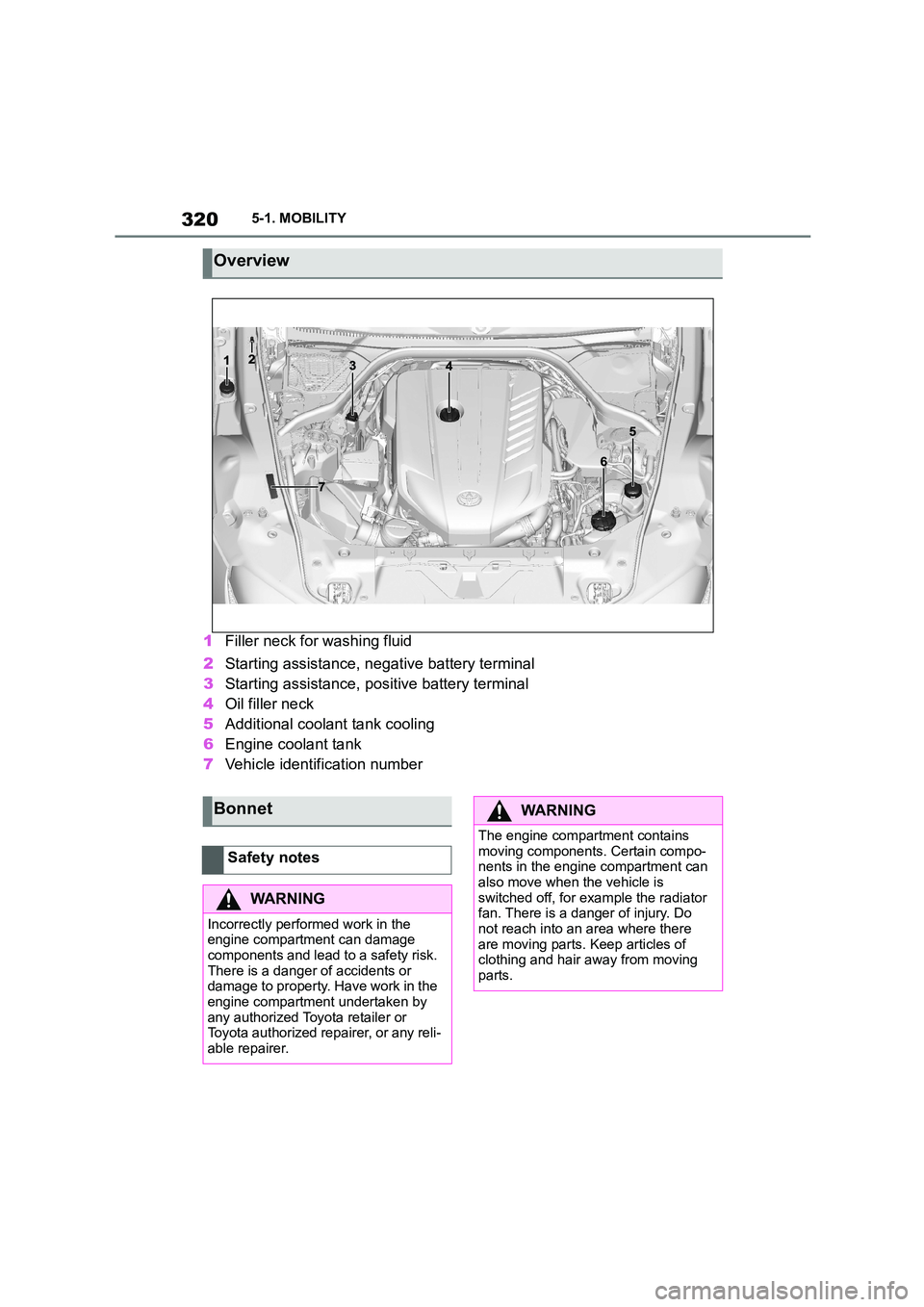
3205-1. MOBILITY
1Filler neck for washing fluid
2 Starting assistance, negative battery terminal
3 Starting assistance, positive battery terminal
4 Oil filler neck
5 Additional coolant tank cooling
6 Engine coolant tank
7 Vehicle identification number
Overview
Bonnet
Safety notes
WA R N I N G
Incorrectly performed work in the
engine compartment can damage components and lead to a safety risk.
There is a danger of accidents or
damage to property. Have work in the engine compartment undertaken by
any authorized Toyota retailer or
Toyota authorized repairer, or any reli- able repairer.
WA R N I N G
The engine compartment contains
moving components. Certain compo- nents in the engine compartment can
also move when the vehicle is
switched off, for example the radiator fan. There is a danger of injury. Do
not reach into an area where there
are moving parts. Keep articles of clothing and hair away from moving
parts.
Page 325 of 498
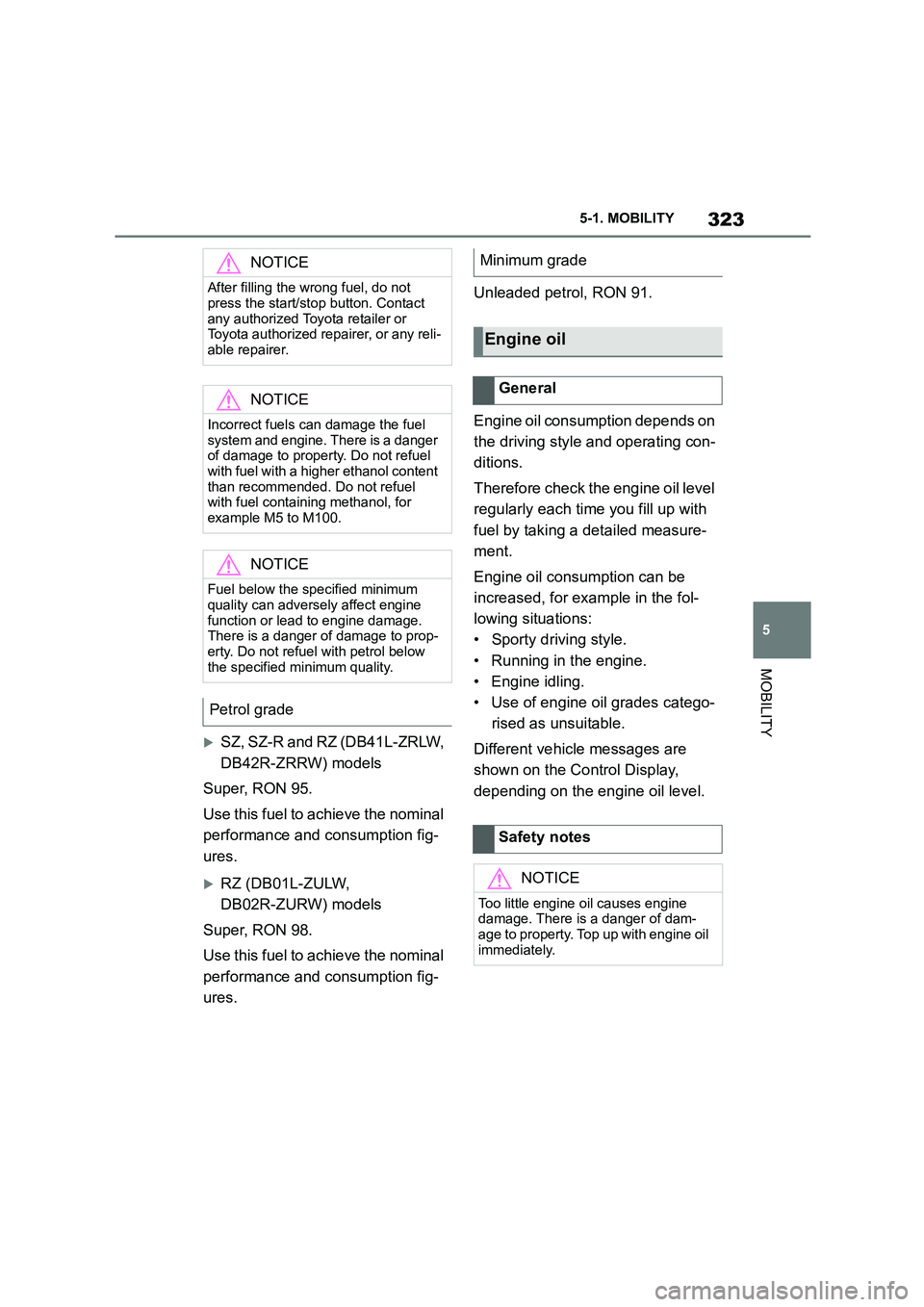
323
5
5-1. MOBILITY
MOBILITY
SZ, SZ-R and RZ (DB41L-ZRLW,
DB42R-ZRRW) models
Super, RON 95.
Use this fuel to achieve the nominal
performance and consumption fig-
ures.
RZ (DB01L-ZULW,
DB02R-ZURW) models
Super, RON 98.
Use this fuel to achieve the nominal
performance and consumption fig-
ures.
Unleaded petrol, RON 91.
Engine oil consumption depends on
the driving style and operating con-
ditions.
Therefore check the engine oil level
regularly each time you fill up with
fuel by taking a detailed measure-
ment.
Engine oil consumption can be
increased, for example in the fol-
lowing situations:
• Sporty driving style.
• Running in the engine.
• Engine idling.
• Use of engine oil grades catego-
rised as unsuitable.
Different vehicle messages are
shown on the Control Display,
depending on the engine oil level.
NOTICE
After filling the wrong fuel, do not
press the start/stop button. Contact
any authorized Toyota retailer or Toyota authorized repairer, or any reli-
able repairer.
NOTICE
Incorrect fuels can damage the fuel
system and engine. There is a danger of damage to property. Do not refuel
with fuel with a higher ethanol content
than recommended. Do not refuel with fuel containing methanol, for
example M5 to M100.
NOTICE
Fuel below the specified minimum quality can adversely affect engine
function or lead to engine damage.
There is a danger of damage to prop- erty. Do not refuel with petrol below
the specified minimum quality.
Petrol grade
Minimum grade
Engine oil
General
Safety notes
NOTICE
Too little engine oil causes engine
damage. There is a danger of dam- age to property. Top up with engine oil
immediately.
Page 326 of 498

3245-1. MOBILITY
Electronic oil measurement uses
two measuring methods:
• Monitoring.
• Detailed measurement.
When frequently making short trips
or using a sporty driving style, for
example taking corners at high
speed, regularly perform a detailed
measurement.
■Principle
The engine oil level is electronically
monitored during the journey and
can be shown on the Control Dis-
play.
If the engine oil level is outside its
permissible operating range, a
vehicle message is shown.
■Operating requirements
A current measurement is available
after approximately 30 minutes of
normal driving.
■Displaying the engine oil level
Via Toyota Supra Command:
1 "My Vehicle"
2 "Vehicle status"
3 "Engine oil level"
The engine oil level is displayed.
■System limits
When frequently making short trips
or using a sporty driving style, it
may not be possible to measure the
oil level. In this case, the measure-
ment for the last, sufficiently long
journey is displayed.
■Principle
The engine oil level is checked
when the vehicle is stationary and
is shown on a scale.
If the engine oil level is outside its
permissible operating range, a
vehicle message is shown.
■General
During measurement, the idle
speed is slightly raised.
■Operating requirements
• Vehicle is standing horizontally.
• Selector lever in selector lever
position N or P and accelerator
pedal not pressed.
• Engine is running and is at oper-
NOTICE
Too much engine oil can damage the
engine or the catalytic converter.
There is a danger of damage to prop- erty. Do not top up with too much
engine oil. If there is too much engine
oil, have the engine oil level corrected by any authorized Toyota retailer or
Toyota authorized repairer, or any reli-
able repairer.
Electronic oil measurement
General
Monitoring
A red indicator lamp is dis-
played if the engine oil
pressure is insufficient.
Detailed measurement
Page 327 of 498
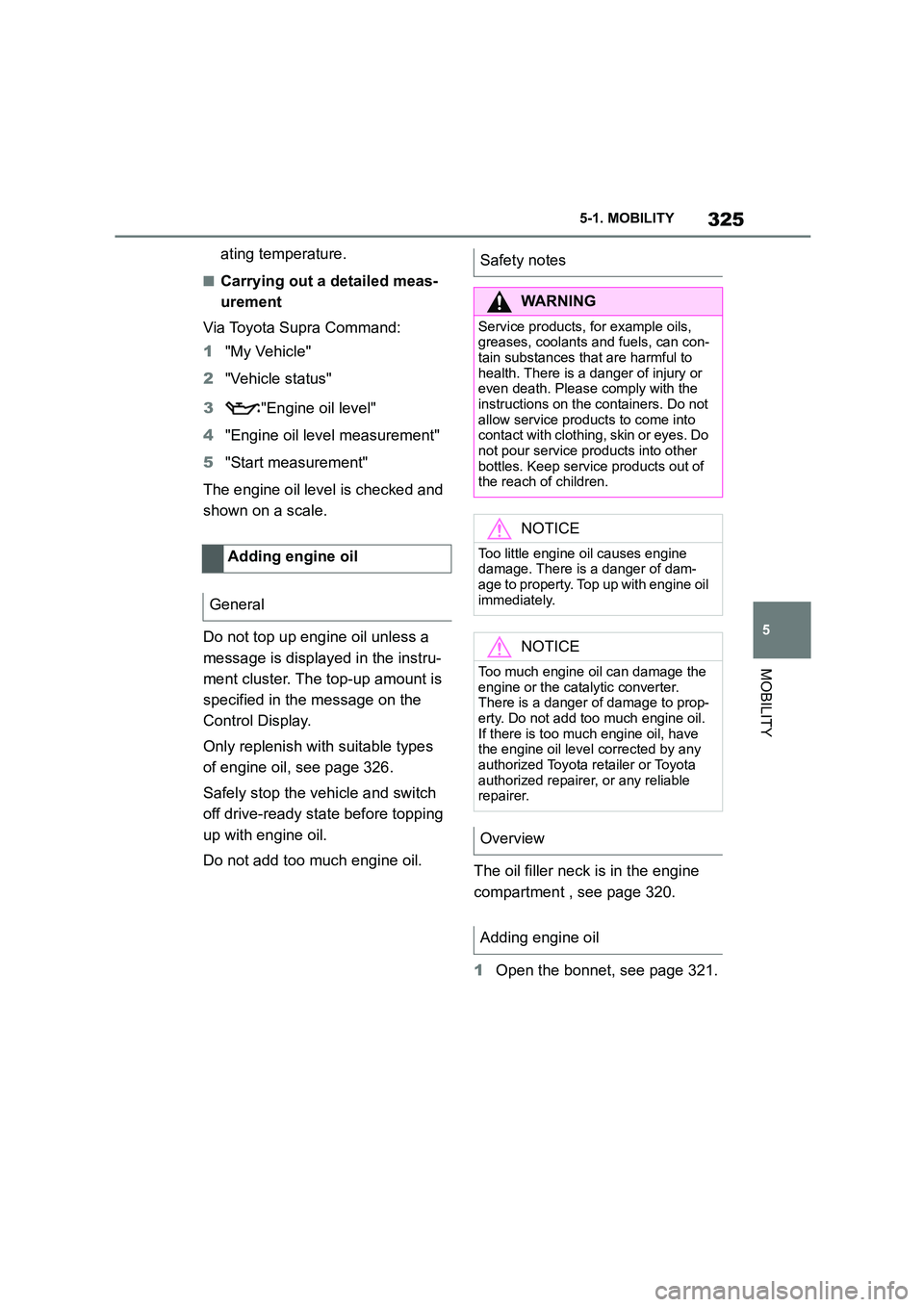
325
5
5-1. MOBILITY
MOBILITY
ating temperature.
■Carrying out a detailed meas-
urement
Via Toyota Supra Command:
1 "My Vehicle"
2 "Vehicle status"
3 "Engine oil level"
4 "Engine oil level measurement"
5 "Start measurement"
The engine oil level is checked and
shown on a scale.
Do not top up engine oil unless a
message is displayed in the instru-
ment cluster. The top-up amount is
specified in the message on the
Control Display.
Only replenish with suitable types
of engine oil, see page 326.
Safely stop the vehicle and switch
off drive-ready state before topping
up with engine oil.
Do not add too much engine oil. The oil filler neck is in the engine
compartment , see page 320.
1 Open the bonnet, see page 321.
Adding engine oil
General
Safety notes
WA R N I N G
Service products, for example oils,
greases, coolants and fuels, can con- tain substances that are harmful to
health. There is a danger of injury or
even death. Please comply with the instructions on the containers. Do not
allow service products to come into
contact with clothing, skin or eyes. Do
not pour service products into other bottles. Keep service products out of
the reach of children.
NOTICE
Too little engine oil causes engine
damage. There is a danger of dam-
age to property. Top up with engine oil immediately.
NOTICE
Too much engine oil can damage the
engine or the catalytic converter. There is a danger of damage to prop-
erty. Do not add too much engine oil.
If there is too much engine oil, have the engine oil level corrected by any
authorized Toyota retailer or Toyota
authorized repairer, or any reliable repairer.
Overview
Adding engine oil
Page 328 of 498
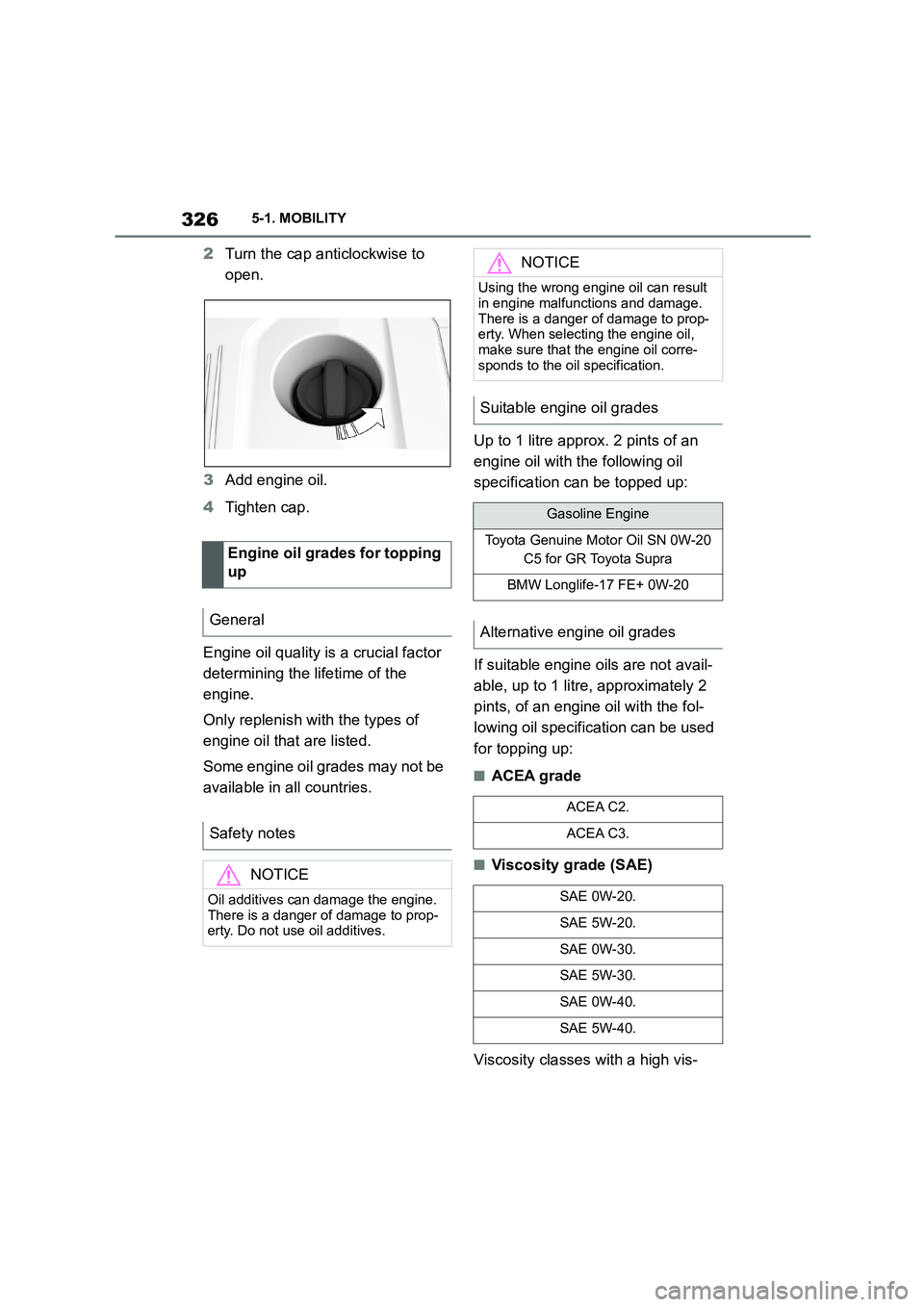
3265-1. MOBILITY
2Turn the cap anticlockwise to
open.
3 Add engine oil.
4 Tighten cap.
Engine oil quality is a crucial factor
determining the lifetime of the
engine.
Only replenish with the types of
engine oil that are listed.
Some engine oil grades may not be
available in all countries.
Up to 1 litre approx. 2 pints of an
engine oil with the following oil
specification can be topped up:
If suitable engine oils are not avail-
able, up to 1 litre, approximately 2
pints, of an engine oil with the fol-
lowing oil specification can be used
for topping up:
■ACEA grade
■Viscosity grade (SAE)
Viscosity classes with a high vis-
Engine oil grades for topping
up
General
Safety notes
NOTICE
Oil additives can damage the engine.
There is a danger of damage to prop- erty. Do not use oil additives.
NOTICE
Using the wrong engine oil can result
in engine malfunctions and damage.
There is a danger of damage to prop- erty. When selecting the engine oil,
make sure that the engine oil corre-
sponds to the oil specification.
Suitable engine oil grades
Gasoline Engine
Toyota Genuine Motor Oil SN 0W-20
C5 for GR Toyota Supra
BMW Longlife-17 FE+ 0W-20
Alternative engine oil grades
ACEA C2.
ACEA C3.
SAE 0W-20.
SAE 5W-20.
SAE 0W-30.
SAE 5W-30.
SAE 0W-40.
SAE 5W-40.